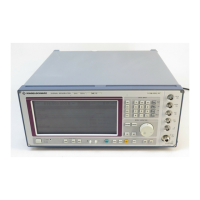Structure and Syntax of the Messages SME
1038.6002.02 3.6 E-13
3.5.2 Structure of a Command
The commands consist of a so-called header and, in most cases, one or more parameters. Header and
parameter are separated by a "white space" (ASCII code 0 to 9, 11 to 32 decimal, e.g. blank). The
headers may consist of several key words. Queries are formed by directly appending a question mark to
the header.
Note: The commands used in the following examples are not in every case implemented in the
instrument.
Common Commands Common commands consist of a header preceded by an asterisk "*"
and one or several parameters, if any.
Examples: *RST RESET, resets the device
*ESE 253 EVENT STATUS ENABLE, sets the bits of the
event status enable registers
*ESR? EVENT STATUS QUERY, queries the
contents of the event status register.
Device-specific commands
Hierarchy: Device-specific commands are of hierarchical structure (see Fig. 3-1).
The different levels are represented by combined headers. Headers of
the highest level (root level) have only one key word. This key word
denotes a complete command system.
Example: SOURce This key word denotes the command
system SOURce.
For commands of lower levels, the complete path has to be specified,
starting on the left with the highest level, the individual key words being
separated by a colon ":".
Example: SOURce:FM:EXTernal:COUPling AC
This command lies in the fourth level of the SOURce system. It sets the
coupling of the external signal source to AC.
SOURce
POWer AM
FM
MODE
INTernal
EXTernal STATePOLarity
POLarity COUPling
Fig. 3-1 Tree structure of the SCPI command systems using the SOURce system by way of example

